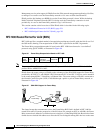
Overview of IBM Networking
NCIA
BC-226
Cisco IOS Bridging and IBM Networking Configuration Guide
78-11737-02
NCIA
Native Client Interface Architecture (NCIA) is a new software architecture introduced by Cisco to make
accessing IBM SNA applications over routed internetworks more scalable and flexible. NCIA is a
component of the Cisco IOS software. The architecture is intended to combine the benefits of the native
SNA interface at end stations and mainframes with those of TCP/IP across the network backbone.
NCIA extends the use of the TCP/IP protocol all the way to the SNA end station. Because of the wide
range of media supported by TCP/IP, including dialup telephone lines for remotely located users, NCIA
makes multiprotocol access to corporate backbone networks much more flexible for SNA users.
NCIA allows SNA end stations such as PCs or workstations to encapsulate SNA traffic in TCP/IP, rather
than requiring the traffic to travel through routers. The first phase of NCIA (NCIA I), used Cisco RSRB
encapsulation. The current phase (NCIA Server) uses a new client/server model. NCIA Server is not
backward compatible to NCIA I.
This section contains a brief overview of NCIA:
• NCIA I, page 226
• NCIA Server, page 226
• Advantages of the Client/Server Model, page 228
NCIA I
The Cisco NCIA server feature implements RFC 2114, Data Link Switch Client Access Protocol. Using
the Cisco RSRB technology, NCIA I encapsulates the Token Ring traffic inside IP datagrams passed over
a TCP connection between a router and a client. A virtual ring is created to allow the router to
interconnect any client. The virtual ring acts as a logical Token Ring in the router, so that all the Token
Rings connected to the router are treated as if they are all on the same Token Ring. The virtual ring is
called a ring group. The ring group number is used just like a physical ring number and shows up in any
route descriptors contained in packets being bridged. A ring group must be assigned a ring number that
is unique throughout the network.
An NCIA I client acts as both an RSRB router and an end station. It must have a “fake” ring number and
a “fake” bridge number so that it looks like an end station sitting on a real Token Ring. The fake ring and
bridge numbers are visible to both the RSRB router and the NCIA client. The client must also have an
LLC2 so that it can handle the LLC2 sessions.
NCIA Server
The NCIA Server feature extends the scalability of NCIA I, enhances its functionality, and provides
support for both the installed base of RSRB routers and the growing number of DLSw+ routers. The
NCIA Server feature includes the following enhancements:
• You do not need to configure a ring number on the client.
• You do not need to configure each client on the router.
• The MAC address can be dynamically assigned by the NCIA server running on the router.
• SNA is directly on top of TCP/IP; LLC2 is no longer required at end station.
• A client is a true end station, not a router peer.


















